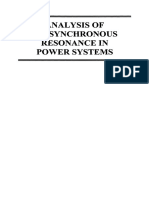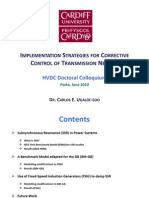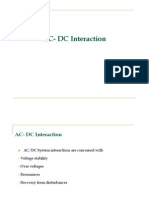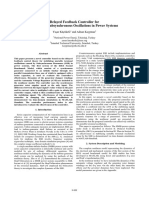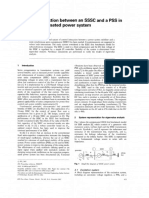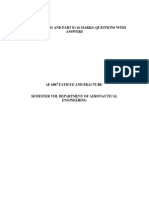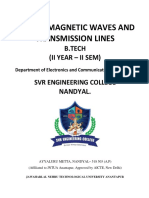Subsynchronous Resonance Analysis
Uploaded by
ijaertSubsynchronous Resonance Analysis
Uploaded by
ijaertInternational Journal of Advanced Engineering Research and Technology (IJAERT)
Volume 2 Issue 9, December 2014, ISSN No.: 2348 8190
SUBSYNCHRONOUS RESONANCE ANALYSIS
Himanshu B. Prajapati
P.G. Student (Electrical Power System)
Prof. Mr. Bhavik Prajapati , Vadodara(Gujarat),India
AbstractSSR basically an electrical power system
condition where electrical network exchange energy
with the turbine generator at one or more natural
frequencies of the combined system below synchronous
frequency of the system ,presence of SSR torque causes
oscillation which case shaft fatigue and possible
damage or failure of shaft for SSR phenomena and their
modelling results are obtained by using linearized
system in MATLAB and their study is performed on
the system adapted from IEEE first bench mark model
for Eigen value analysis and mitigation technique. The
different parameter for IEEE first benchmark model of
SSR modelling using mitigation technique and their
study is performed and result analysis in MATLAB.
KeywordsSSR ; IEEE Benchmark System
I.
INTRODUCTION
Series capacitor compensation in AC transmission
systems is an economical means to increase load
carrying capability, Control load sharing among parallel
lines and enhance transient stability. However,
capacitors in series with transmission lines may cause
sub synchronous resonance that can lead to turbinegenerator shaft failure and electrical instability at
oscillation frequencies lower than the normal system
frequency. Therefore, the effects of SSR must be fully
understood and analyzed when planning series capacitor
compensation in power systems. The main concern with
SSR is the possibility of shaft damage from torsional
stresses. Damage can result from the long term
cumulative effects of low amplitude torsional
oscillations or the short term effects of high amplitude
torques. Typically, hydro units have mechanical
parameters that are less prone to SSR problems than
thermal units [3].
Sub synchronous oscillations were first
discussed in 1937 and until 1971, shaft torsional
oscillations were neglected. Two shaft failures at the
Mohave Generating Station in Southern Nevada led to
the understanding and development of the theory of
interaction between series capacitor compensated lines
and the torsional modes of steam turbine generators [1].
After the second shaft failure at Mohave, the utility
industry devoted considerable effort to the analysis and
suppression of the SSR phenomenon.
II.
TYPES OF SSR INTERACTION
There are three types of SSR interactions which are
Induction Generator Effect, Torsional Interaction Effect
and Transient Torque Effect.
A.Induction Generator Effect
Three phase current at sub synchronous frequency can
result due to a nearby network disturbance. When the
sub synchronous frequency currents flow through the
generator armature, they view the synchronously
rotating rotors circuit as negative resistance. If this
negative resistance is greater than the sum of the
armature and network resistance, the electrical system is
self-excited. Such self-excitation would be expected to
result in excessive voltage and current [2]
B. Torsional Interaction
Torsional interaction occurs when the induced sub
synchronous torque in the generator is close to one of
the torsional natural modes of the turbine generator
shaft. When this happens, generator rotor oscillations
will build up and this motion will induce armature
voltage components at both sub synchronous and super
synchronous frequencies. Moreover, the induced sub
synchronous frequency voltage is phased to sustain the
sub synchronous torque. If this torque equals or exceeds
the inherent mechanical damping of the rotating
system, the system will become self-excited. This
phenomenon is called torsional interaction."
C.Transient Torque
Transient torques is those that result from system
disturbances. System disturbances cause sudden
changes in the network, resulting in sudden changes in
currents that will tend to oscillate at the natural
frequencies of the network. In a transmission system
without series capacitors, these transients are always dc
transients, which decay to zero with a time constant that
depends on the ratio of inductance to resistance. For
networks that contain series capacitors, the transient
currents will be of a form similar to above equation, and
will contain one or more oscillatory frequencies that
depend on the network capacitance as well as the
inductance and resistance. In a simple radial R-L C
system, there will be only one such natural frequency,
which is exactly the situation described in above
equation , but in a network with many series capacitors
there will be many such Sub synchronous frequencies.
If any of these sub synchronous network frequencies
www.ijaert.org
355
International Journal of Advanced Engineering Research and Technology (IJAERT)
Volume 2 Issue 9, December 2014, ISSN No.: 2348 8190
coincide with one of the natural modes of a turbinegenerator shaft, there can be peak torques that are quite
large since these torques are directly proportional to the
magnitude of the oscillating.
III.
IEEE FIRST BENCHMARK SYSTEM
The single line diagram of a Single Machine Infinite
Bus system given by IEEE committee for SSR study is
shown in fig.1.
Fig1
The circuit parameters are expressed in per unit on
the generator MVA rating at 60Hz. Reactance are
proportional to frequency, resistances are constant. The
infinite bus is a 3-phase 60 Hz voltage source with zero
impedance at all frequencies.
A.Synchronous Machine Model
Simple model of synchronous generators are not
suitable for accurate description of the power results in
time invariant machine equations. So we consider
machine in the park reference frame which is rotor
reference frame with one damper winding in D-axis and
two damper winding in Q-axis shown in fig 2.
This model shows three phase armature winding on
stator i.e. a, b and c and four winding on the rotor
including field winding f. The damper winding is
represented by equivalent damper circuit in the direct
axis and quadrature axis: 1d on d-axis and 1q and 2q on
q-axis.
Two equivalent rotor circuits are represented in each
axis of the rotor - F and D in the d-axis, and G and Q in
the q-axis, with positive current direction defined as the
direction causing positive magnetization of the defined
d- and q-axis direction [4], respectively. Synchronous
machine operation under balanced three-phase
conditions is of particular interest for SSR analysis.
In first IEEE benchmark system circuit parameters
are expressed in per unit on the generator base of 892.4
MVA, 60 Hz frequency. Reactance is proportional to
frequency and resistances are constant. This system
configuration corresponds to the Navajo Projects 892.4
MVA, 500 kV transmission system.
B. Multi Mass Model of the Turbine- Generator
shaft
The turbine-generator mechanical system consists of
six masses; high-pressure turbine (HP), intermediatepressure turbine (IP), low pressure turbine A (LPA) and
low pressure turbine B (LPB), an exciter (EXC), and a
generator (GEN) coupled to a common shaft as shown
in Fig.2. The turbine masses, generator rotor and exciter
are considered as lumped masses (rigid body) connected
to each other via massless springs [4]
Fig. 3 Mechanical structure of six mass FBM system
From fig 3 the torques acting on the generator mass
is:
Generator:
Input torque
(1)
output torque
(2)
Damping
(3)
Low pressure turbine B:
Input torque
(4)
Output torque
(5)
Damping
(6)
Similarly all other masses torque equation can be
derived.
Fig. 2 schematic
synchronous machine
diagram
of
conventional
IV. SIMULATION AND RESULTS
MATLAB simulation for IEEE first benchmark
system is shown in fig. 4
www.ijaert.org
356
International Journal of Advanced Engineering Research and Technology (IJAERT)
Volume 2 Issue 9, December 2014, ISSN No.: 2348 8190
Fig. 6 Variation of shaft torque
Fig 4
The machine and circuit parameters are real value taken
from the Navajo Project [Appendix]. For the transient
case, single phase to ground fault is applied as shown in
figure 4 for duration of 80 msec(4 cycle) from 0.1
seconds to 0.175 seconds. In the reference paper, fault
reactance is 0.04 p.u.and it is adjusted to produce a
capacitor transient voltage approaching the lower gap
setting.
Capacitor voltage, Generator current, Generator
Electrical Torque, Shaft Torque, speed is plotted for the
time duration 1.0Second.
Fig.7 Waveform for shaft speed(pu)
Fig.5 shows variation of Electrical torque of the
synchronous generator. It is clear that the torque is not
constant for some times after application of fault. That
shows the electrical transmission network resonant
frequency matches one of the natural modes of the multi
mass turbine. Fig. 6 shows the shaft torque. From the
graph, it is seen that the shaft torque oscillates due to
SSR phenomena. Fig. 8 shows the variation of voltage
across the capacitor due to SSR.
Fig. 9 shows the variation of the machine current in per
unit. From the graph, it is seen that the machine phase
current is
oscillatory.
Fig.8 Variation in capacitor voltage
Fig.9 Variation in system current
V. CONCLUSION
Fig. 5 Variation of electromagnetic torque
Sub synchronous resonance effect is studied using IEEE
First Benchmark system and the results have been
investigated. It is observed that series compensation
produces Sub synchronous resonance, during fault
conditions. Sub synchronous Resonance Phenomena is
www.ijaert.org
357
International Journal of Advanced Engineering Research and Technology (IJAERT)
Volume 2 Issue 9, December 2014, ISSN No.: 2348 8190
simulated by exciting the torsional modes with single
phase to ground fault for duration of four cycles. Result
shows that Electromagnetic torque and voltage across
the capacitor are highly distorted.
Appendix
Network parameter of the system is as follows:
A. Generator parameters
Rated MVA: 892.4
Rated voltage: 26.0kv
Power factor: 0.9 lagging
Table-1:Parameters of generator
Parameter
Value
Parameter
Value
Xa
0.13pu
Xd
1.79pu
Xd
0.169pu
X1
0.135pu
Xq
1.71pu
Xq
0.228pu
Xq
0.2pu
Ra
0.002pu
4.3s
Td0
0.032s
0.85s
Tq0
0.05s
Td0
Tq0
Table-2: Mechanical Parameters
Mass
Ineratia
Torque
(second) fraction
HP
0.0929
0.30
IP
0.1556
0.26
LPA
0.8587
0.22
LPB
0.8842
0.22
GEN
0.8686
Shaft
HP-IP
IP-LPA
LPA-LPB
LPBGEN
-
REFERENCES
[1] IEEE SSR Working Group, First Benchmark
Model for Computer Simulation of Sub-synchronous
Resonance, IEEE Transactions on Power Apparatus
and Systems, Vol. PAS 96, no. 5, September/October
1977.
[2] IEEE Committee Report, Rearers Guide To
Sub-synchronous
Resonance,
Sub-synchronous
Resonance Working Group of the System Dynamic
Performance Subcommittee, IEEE Transactions on
Power Systems. Vol. 7, No. 1, February 1992
[3] K.R. Padiyar, Power System Dynamics Stability
and Control, Indian Institute of Science, Bangalore,
1996.
[4] K.G.Prajapati,A.M.Upadhyay,1M.E.
[Electrical]
Student, 2Associates Professors Simulation of IEEE
FIRST BANCHMARK Model for SSR Studies
IJSRD - International Journal for Scientific Research &
Development| Vol. 1, Issue 3, 2013 | ISSN (online):
2321-0613
[5] N.G.Hingorani,L.gyugyi,Understand
FACTS:concept and technology of flexible AC
transmission systems, New York:IEEE press ,2000
[6] MATLAB and SIMULINK demos and
documentation.
[online].
Available
:
http://
www.mathwork.com
Spring
Constant
7277pu
13168pu
19618pu
26713pu
-
Transformer parameter
Rated MVA : 892.4
Voltage rating : 26/539kv
Delta/star grounded
R = 0.00792 pu
X = 0.14 pu,
X0 = 0.14 pu
Transmission line parameter
R = 0.02pu,
X = 0.50pu
Series capacitor
C = 0.371pu
Infinite bus
Voltage: 500kv,
Phase angle: 0
www.ijaert.org
358
You might also like
- Subsynchronous Resonance Analysis: Types OF SSR InteractionNo ratings yetSubsynchronous Resonance Analysis: Types OF SSR Interaction4 pages
- Reader Guide To Subsynchronous ResonanceNo ratings yetReader Guide To Subsynchronous Resonance8 pages
- Simulation of IEEE First Benchmark Model For SSR StudiesNo ratings yetSimulation of IEEE First Benchmark Model For SSR Studies4 pages
- Simulation of First Benchmark Model For Analysis of Subsynchronous Resonance in Power Systems Using SequelNo ratings yetSimulation of First Benchmark Model For Analysis of Subsynchronous Resonance in Power Systems Using Sequel7 pages
- Damping of Sub Synchronous Resonance Using SSSC Based PWM Hysteresis ControllerNo ratings yetDamping of Sub Synchronous Resonance Using SSSC Based PWM Hysteresis Controller9 pages
- A Simplified System For Subsynchronous Resonance StudiesNo ratings yetA Simplified System For Subsynchronous Resonance Studies6 pages
- Subsynchronous Oscillation Detection Using Microprocessor Relays100% (1)Subsynchronous Oscillation Detection Using Microprocessor Relays12 pages
- K. R. Padiyar Auth. Analysis of Subsynchronous Resonance in Power Systems PDF100% (1)K. R. Padiyar Auth. Analysis of Subsynchronous Resonance in Power Systems PDF271 pages
- Analysis of Subsynchronous Resonance in Power Systems100% (1)Analysis of Subsynchronous Resonance in Power Systems271 pages
- Study of Sub Synchronous Resonance On IEEE Second Benchmark Model and Its Mitigation Using Thyristor Controlled Series Capacitor (TCSC)No ratings yetStudy of Sub Synchronous Resonance On IEEE Second Benchmark Model and Its Mitigation Using Thyristor Controlled Series Capacitor (TCSC)6 pages
- Simulation of Some Power Electronics Case Studies in Matlab Simpowersystem BlocksetFrom EverandSimulation of Some Power Electronics Case Studies in Matlab Simpowersystem BlocksetNo ratings yet
- Simulation of Some Power Electronics Case Studies in Matlab Simpowersystem BlocksetFrom EverandSimulation of Some Power Electronics Case Studies in Matlab Simpowersystem BlocksetNo ratings yet
- Some Power Electronics Case Studies Using Matlab Simpowersystem BlocksetFrom EverandSome Power Electronics Case Studies Using Matlab Simpowersystem BlocksetNo ratings yet
- Sub Synchronous Resonance Damping in Interconnected Power Systems100% (1)Sub Synchronous Resonance Damping in Interconnected Power Systems4 pages
- Simulation of Some Power System, Control System and Power Electronics Case Studies Using Matlab and PowerWorld SimulatorFrom EverandSimulation of Some Power System, Control System and Power Electronics Case Studies Using Matlab and PowerWorld SimulatorNo ratings yet
- Subsynchronour Ressonance Impact - Article 3 Vol 41 Issue 4 1998No ratings yetSubsynchronour Ressonance Impact - Article 3 Vol 41 Issue 4 19986 pages
- Understanding Generator Power System Stabilizer100% (4)Understanding Generator Power System Stabilizer12 pages
- Basler Elect Understanding Power System StabilityNo ratings yetBasler Elect Understanding Power System Stability11 pages
- Steam Turbine Generator Torsional CharacteristicsNo ratings yetSteam Turbine Generator Torsional Characteristics19 pages
- Has I) .: Has Been and Continues To Be Performed To Devise Methods ofNo ratings yetHas I) .: Has Been and Continues To Be Performed To Devise Methods of3 pages
- Sub Synchronous Resonance: Facts ControllersNo ratings yetSub Synchronous Resonance: Facts Controllers17 pages
- Mitigation of Sub Synchronous Oscillations in ANo ratings yetMitigation of Sub Synchronous Oscillations in A7 pages
- Thesis - Ebe - 2022 - Chikohora Tinashe EdwardNo ratings yetThesis - Ebe - 2022 - Chikohora Tinashe Edward125 pages
- Effect of Compensation Factor On The Subsynchronous Resonance in Single Machine Infinite Bus SystemNo ratings yetEffect of Compensation Factor On The Subsynchronous Resonance in Single Machine Infinite Bus System6 pages
- Investigation of Frequency Reduction Behavior On Three Phase Synchronous Generator and TransformerNo ratings yetInvestigation of Frequency Reduction Behavior On Three Phase Synchronous Generator and Transformer17 pages
- Handbook of Power Systems Engineering with Power Electronics ApplicationsFrom EverandHandbook of Power Systems Engineering with Power Electronics ApplicationsNo ratings yet
- Suppression of Subsynchronous Resonance by A Parallel Connected Damper CircuitNo ratings yetSuppression of Subsynchronous Resonance by A Parallel Connected Damper Circuit6 pages
- VSCC - PowerFactory - Benchmark - v1 - Part II100% (1)VSCC - PowerFactory - Benchmark - v1 - Part II15 pages
- Subsynchronous Resonance and FACTS-Novel Control Strategy For Its MitigationNo ratings yetSubsynchronous Resonance and FACTS-Novel Control Strategy For Its Mitigation15 pages
- J. World. Elect. Eng. Tech. 1 (1) 27-34, 2012No ratings yetJ. World. Elect. Eng. Tech. 1 (1) 27-34, 20128 pages
- Damping Torsional Oscillations in Large Turbo-Generators Using Thyristor Controlled Braking ResistorsNo ratings yetDamping Torsional Oscillations in Large Turbo-Generators Using Thyristor Controlled Braking Resistors7 pages
- Power System Transient Analysis: Theory and Practice using Simulation Programs (ATP-EMTP)From EverandPower System Transient Analysis: Theory and Practice using Simulation Programs (ATP-EMTP)No ratings yet
- Qaid 2021 IOP Conf. Ser. Mater. Sci. Eng. 1127 012034No ratings yetQaid 2021 IOP Conf. Ser. Mater. Sci. Eng. 1127 0120349 pages
- Subsynchronous Resonance in Power SystemsNo ratings yetSubsynchronous Resonance in Power Systems272 pages
- SSR Mitigation With A New Control of PV Solar Farm As Statcom (Pv-Statcom)No ratings yetSSR Mitigation With A New Control of PV Solar Farm As Statcom (Pv-Statcom)11 pages
- 01 - Mathematical Modeling of the Squirrel Cage Induction generator based wind farm for sub-synchronous resonance analysisNo ratings yet01 - Mathematical Modeling of the Squirrel Cage Induction generator based wind farm for sub-synchronous resonance analysis7 pages
- Simulation and Analysis of LLC Resonant Converter Using Closed Loop PI ControllerNo ratings yetSimulation and Analysis of LLC Resonant Converter Using Closed Loop PI Controller3 pages
- Changes in The Physical State of Ceramics Materials Brought About by The Removal of Free WaterNo ratings yetChanges in The Physical State of Ceramics Materials Brought About by The Removal of Free Water5 pages
- Self-Medical Analysis Using Internet-Based Computing Upon Big DataNo ratings yetSelf-Medical Analysis Using Internet-Based Computing Upon Big Data6 pages
- Detection of Melanoma Using Asymmetric FeaturesNo ratings yetDetection of Melanoma Using Asymmetric Features7 pages
- Advancement in Knitted Structure For Industrial Applications - A ReviewNo ratings yetAdvancement in Knitted Structure For Industrial Applications - A Review8 pages
- A Review On Ceramics and Its Economic EmpowermentNo ratings yetA Review On Ceramics and Its Economic Empowerment4 pages
- Characterization of Ezzodo Clay Deposit For Its Industrial PotentialsNo ratings yetCharacterization of Ezzodo Clay Deposit For Its Industrial Potentials8 pages
- A Review On Synthesis, Characterization and Applications of Silica ParticlesNo ratings yetA Review On Synthesis, Characterization and Applications of Silica Particles7 pages
- Design of Robust Type-2 Fuzzy Logic Power System Stabilizer Using Hopf BifurcationsNo ratings yetDesign of Robust Type-2 Fuzzy Logic Power System Stabilizer Using Hopf Bifurcations5 pages
- Optimization of Gear To Improve Performance of Gearbox100% (1)Optimization of Gear To Improve Performance of Gearbox4 pages
- Design and Fabrication of Vertical Axis Wind Turbine (VAWT)No ratings yetDesign and Fabrication of Vertical Axis Wind Turbine (VAWT)3 pages
- Feature Selection Approach For Intrusion Detection System Based On Pollination AlgorithmNo ratings yetFeature Selection Approach For Intrusion Detection System Based On Pollination Algorithm5 pages
- Behaviour of Concrete Partially Replacement of Cement by Steatite and Polypropylene FibreNo ratings yetBehaviour of Concrete Partially Replacement of Cement by Steatite and Polypropylene Fibre4 pages
- Comparative Analysis On Partial Replacement of Cement by Flyash and Coarse Aggregate by Ceramic WasteNo ratings yetComparative Analysis On Partial Replacement of Cement by Flyash and Coarse Aggregate by Ceramic Waste4 pages
- Comparative Analysis On Partial Replacement of Cement by Metakaolin and Fine Aggregate by Granite PowderNo ratings yetComparative Analysis On Partial Replacement of Cement by Metakaolin and Fine Aggregate by Granite Powder5 pages
- Structural Optimization of Composite Railway SleepersNo ratings yetStructural Optimization of Composite Railway Sleepers6 pages
- Chapter 3 Centrifugal Compressors and Fans (Modified)No ratings yetChapter 3 Centrifugal Compressors and Fans (Modified)44 pages
- Physics Experiment Report (Iv) Basic Physics "Oscillation Mathematics"No ratings yetPhysics Experiment Report (Iv) Basic Physics "Oscillation Mathematics"8 pages
- A Study of The Seismic Response of Reinforced Soil Retaining Walls To Rocking Ground ExcitationNo ratings yetA Study of The Seismic Response of Reinforced Soil Retaining Walls To Rocking Ground Excitation11 pages
- MC 2009 - 3 Documents To Be Submitted in Lieu of The Required Certificate of Finality Involving Court Decrees-Decision-OrdersNo ratings yetMC 2009 - 3 Documents To Be Submitted in Lieu of The Required Certificate of Finality Involving Court Decrees-Decision-Orders4 pages
- Electromagnetic Waves and Transmission LinesNo ratings yetElectromagnetic Waves and Transmission Lines180 pages
- (Ii) Eequatorial : (Ii) E¡xial and For Short Dipole, E¡xial and For Short Dipole EequatorialNo ratings yet(Ii) Eequatorial : (Ii) E¡xial and For Short Dipole, E¡xial and For Short Dipole Eequatorial4 pages
- Digital Image Processing (CS/ECE 545) Lecture 4: Filters (Part 2) & Edges and ContoursNo ratings yetDigital Image Processing (CS/ECE 545) Lecture 4: Filters (Part 2) & Edges and Contours74 pages
- Quadcopter Simulation: Jose Carlos LopezNo ratings yetQuadcopter Simulation: Jose Carlos Lopez4 pages
- Subsynchronous Resonance Analysis: Types OF SSR InteractionSubsynchronous Resonance Analysis: Types OF SSR Interaction
- Simulation of IEEE First Benchmark Model For SSR StudiesSimulation of IEEE First Benchmark Model For SSR Studies
- Simulation of First Benchmark Model For Analysis of Subsynchronous Resonance in Power Systems Using SequelSimulation of First Benchmark Model For Analysis of Subsynchronous Resonance in Power Systems Using Sequel
- Damping of Sub Synchronous Resonance Using SSSC Based PWM Hysteresis ControllerDamping of Sub Synchronous Resonance Using SSSC Based PWM Hysteresis Controller
- A Simplified System For Subsynchronous Resonance StudiesA Simplified System For Subsynchronous Resonance Studies
- Subsynchronous Oscillation Detection Using Microprocessor RelaysSubsynchronous Oscillation Detection Using Microprocessor Relays
- K. R. Padiyar Auth. Analysis of Subsynchronous Resonance in Power Systems PDFK. R. Padiyar Auth. Analysis of Subsynchronous Resonance in Power Systems PDF
- Analysis of Subsynchronous Resonance in Power SystemsAnalysis of Subsynchronous Resonance in Power Systems
- Study of Sub Synchronous Resonance On IEEE Second Benchmark Model and Its Mitigation Using Thyristor Controlled Series Capacitor (TCSC)Study of Sub Synchronous Resonance On IEEE Second Benchmark Model and Its Mitigation Using Thyristor Controlled Series Capacitor (TCSC)
- Simulation of Some Power Electronics Case Studies in Matlab Simpowersystem BlocksetFrom EverandSimulation of Some Power Electronics Case Studies in Matlab Simpowersystem Blockset
- Simulation of Some Power Electronics Case Studies in Matlab Simpowersystem BlocksetFrom EverandSimulation of Some Power Electronics Case Studies in Matlab Simpowersystem Blockset
- Some Power Electronics Case Studies Using Matlab Simpowersystem BlocksetFrom EverandSome Power Electronics Case Studies Using Matlab Simpowersystem Blockset
- Sub Synchronous Resonance Damping in Interconnected Power SystemsSub Synchronous Resonance Damping in Interconnected Power Systems
- Simulation of Some Power System, Control System and Power Electronics Case Studies Using Matlab and PowerWorld SimulatorFrom EverandSimulation of Some Power System, Control System and Power Electronics Case Studies Using Matlab and PowerWorld Simulator
- Subsynchronour Ressonance Impact - Article 3 Vol 41 Issue 4 1998Subsynchronour Ressonance Impact - Article 3 Vol 41 Issue 4 1998
- Has I) .: Has Been and Continues To Be Performed To Devise Methods ofHas I) .: Has Been and Continues To Be Performed To Devise Methods of
- Effect of Compensation Factor On The Subsynchronous Resonance in Single Machine Infinite Bus SystemEffect of Compensation Factor On The Subsynchronous Resonance in Single Machine Infinite Bus System
- Investigation of Frequency Reduction Behavior On Three Phase Synchronous Generator and TransformerInvestigation of Frequency Reduction Behavior On Three Phase Synchronous Generator and Transformer
- Handbook of Power Systems Engineering with Power Electronics ApplicationsFrom EverandHandbook of Power Systems Engineering with Power Electronics Applications
- Suppression of Subsynchronous Resonance by A Parallel Connected Damper CircuitSuppression of Subsynchronous Resonance by A Parallel Connected Damper Circuit
- Subsynchronous Resonance and FACTS-Novel Control Strategy For Its MitigationSubsynchronous Resonance and FACTS-Novel Control Strategy For Its Mitigation
- Damping Torsional Oscillations in Large Turbo-Generators Using Thyristor Controlled Braking ResistorsDamping Torsional Oscillations in Large Turbo-Generators Using Thyristor Controlled Braking Resistors
- Power, Testing, and Grounding of Electronic SystemsFrom EverandPower, Testing, and Grounding of Electronic Systems
- Power System Transient Analysis: Theory and Practice using Simulation Programs (ATP-EMTP)From EverandPower System Transient Analysis: Theory and Practice using Simulation Programs (ATP-EMTP)
- Qaid 2021 IOP Conf. Ser. Mater. Sci. Eng. 1127 012034Qaid 2021 IOP Conf. Ser. Mater. Sci. Eng. 1127 012034
- SSR Mitigation With A New Control of PV Solar Farm As Statcom (Pv-Statcom)SSR Mitigation With A New Control of PV Solar Farm As Statcom (Pv-Statcom)
- 01 - Mathematical Modeling of the Squirrel Cage Induction generator based wind farm for sub-synchronous resonance analysis01 - Mathematical Modeling of the Squirrel Cage Induction generator based wind farm for sub-synchronous resonance analysis
- Computer Methods in Power Systems Analysis with MATLABFrom EverandComputer Methods in Power Systems Analysis with MATLAB
- Simulation and Analysis of LLC Resonant Converter Using Closed Loop PI ControllerSimulation and Analysis of LLC Resonant Converter Using Closed Loop PI Controller
- Changes in The Physical State of Ceramics Materials Brought About by The Removal of Free WaterChanges in The Physical State of Ceramics Materials Brought About by The Removal of Free Water
- Self-Medical Analysis Using Internet-Based Computing Upon Big DataSelf-Medical Analysis Using Internet-Based Computing Upon Big Data
- Advancement in Knitted Structure For Industrial Applications - A ReviewAdvancement in Knitted Structure For Industrial Applications - A Review
- Characterization of Ezzodo Clay Deposit For Its Industrial PotentialsCharacterization of Ezzodo Clay Deposit For Its Industrial Potentials
- A Review On Synthesis, Characterization and Applications of Silica ParticlesA Review On Synthesis, Characterization and Applications of Silica Particles
- Design of Robust Type-2 Fuzzy Logic Power System Stabilizer Using Hopf BifurcationsDesign of Robust Type-2 Fuzzy Logic Power System Stabilizer Using Hopf Bifurcations
- Optimization of Gear To Improve Performance of GearboxOptimization of Gear To Improve Performance of Gearbox
- Design and Fabrication of Vertical Axis Wind Turbine (VAWT)Design and Fabrication of Vertical Axis Wind Turbine (VAWT)
- Feature Selection Approach For Intrusion Detection System Based On Pollination AlgorithmFeature Selection Approach For Intrusion Detection System Based On Pollination Algorithm
- Behaviour of Concrete Partially Replacement of Cement by Steatite and Polypropylene FibreBehaviour of Concrete Partially Replacement of Cement by Steatite and Polypropylene Fibre
- Comparative Analysis On Partial Replacement of Cement by Flyash and Coarse Aggregate by Ceramic WasteComparative Analysis On Partial Replacement of Cement by Flyash and Coarse Aggregate by Ceramic Waste
- Comparative Analysis On Partial Replacement of Cement by Metakaolin and Fine Aggregate by Granite PowderComparative Analysis On Partial Replacement of Cement by Metakaolin and Fine Aggregate by Granite Powder
- Structural Optimization of Composite Railway SleepersStructural Optimization of Composite Railway Sleepers
- Chapter 3 Centrifugal Compressors and Fans (Modified)Chapter 3 Centrifugal Compressors and Fans (Modified)
- Physics Experiment Report (Iv) Basic Physics "Oscillation Mathematics"Physics Experiment Report (Iv) Basic Physics "Oscillation Mathematics"
- A Study of The Seismic Response of Reinforced Soil Retaining Walls To Rocking Ground ExcitationA Study of The Seismic Response of Reinforced Soil Retaining Walls To Rocking Ground Excitation
- MC 2009 - 3 Documents To Be Submitted in Lieu of The Required Certificate of Finality Involving Court Decrees-Decision-OrdersMC 2009 - 3 Documents To Be Submitted in Lieu of The Required Certificate of Finality Involving Court Decrees-Decision-Orders
- (Ii) Eequatorial : (Ii) E¡xial and For Short Dipole, E¡xial and For Short Dipole Eequatorial(Ii) Eequatorial : (Ii) E¡xial and For Short Dipole, E¡xial and For Short Dipole Eequatorial
- Digital Image Processing (CS/ECE 545) Lecture 4: Filters (Part 2) & Edges and ContoursDigital Image Processing (CS/ECE 545) Lecture 4: Filters (Part 2) & Edges and Contours














